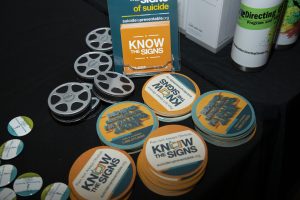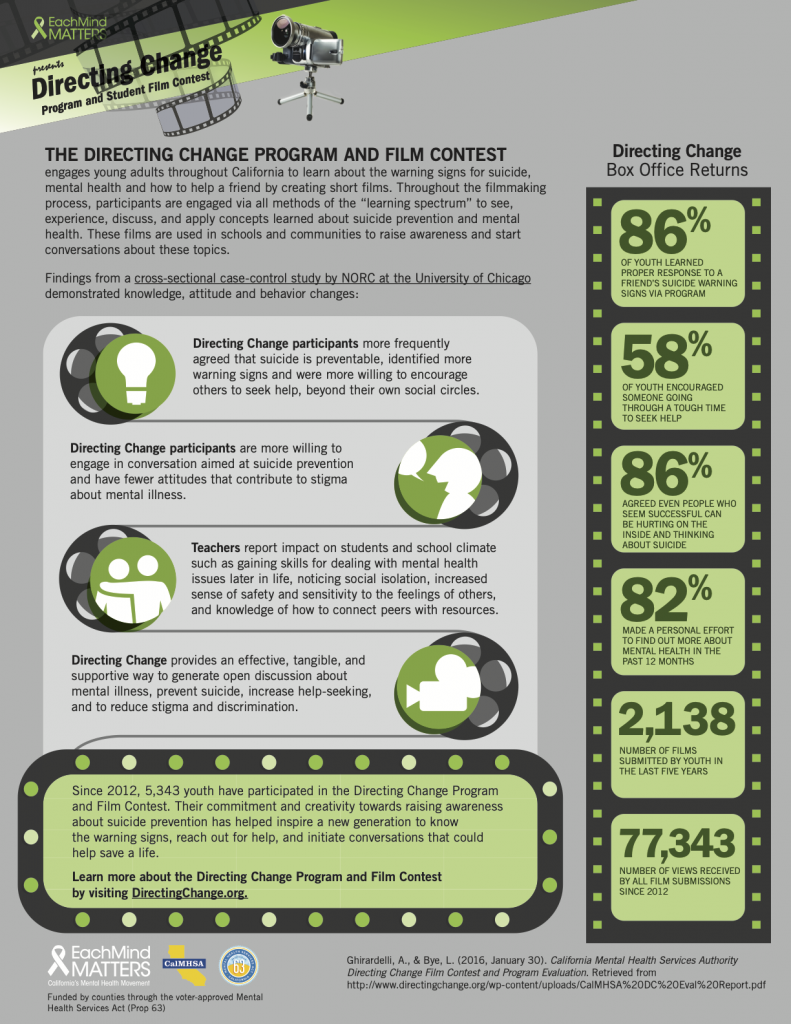Thank you! We can’t do this work without your support.
Directing Change is a non-profit organization (501 c3) and great appreciates your financial support. Every donation counts! (Donate here).
CalHOPE and the Children and Youth Behavioral Health Initiative (CYBHI) are programs of the CA Department of Health Care Services designed to help young people navigate the stress, anxiety, and depression they may experience from the many challenges they face. Youth engagement and youth voice are essential in the design and implementation of programs.

Directing Change is part of statewide efforts to prevent suicide, reduce stigma and discrimination related to mental illness, and to promote the mental health and wellness of students. These initiatives are funded by counties through the Mental Health Services Act (Prop 63) and administered by the California Mental Health Services Authority (CalMHSA), an organization of county governments working to improve mental health outcomes for individuals, families and communities. For more information, visit calmhsa.org
Mission Statement: To educate young people about critical health topics through the medium of film and promote social justice by changing conversations in schools and communities.
Directing Change is part of statewide efforts to prevent suicide, reduce stigma and discrimination related to mental illness, and to promote the mental health and wellness of students. These initiatives are funded by counties through the Mental Health Services Act (Prop 63) and administered by the California Mental Health Services Authority (CalMHSA), an organization of county governments working to improve mental health outcomes for individuals, families and communities.
The program was created by and has been implemented since 2011 by Your Social Marketer, Inc. As of December 20, 2017 the Directing Change Program and Film Contest is a nonprofit organization.
View the Report on Preliminary Findings of the Directing Change Program 2020/21 provided by NYU in May 2022, the 2017 NORC Evaluation Infographic prepared by NORC at the University of Chicago and the Directing Change 2020 Outcome Statement to learn about the impact Directing Change is having in your community.



The Directing Change Program and Film Contest engages students and young people throughout California to learn about the topics of suicide prevention and mental health in an innovative way: a film contest.
We learn through actions and when we apply knowledge our minds begin to change. Anyone can read about the signs of suicide or mental illness, but to create a short film about them, be respectful, and think deeply about impacting the opinion of others requires a level of involvement that has lasting impact.
The Directing Change Program starts with exposing youth to knowledge about the topics of mental health and suicide prevention by providing instructional tools to educators, educational resources to youth, and additional resources to further learning about the basic components of suicide prevention. From here, youth must apply suicide prevention knowledge to formulate and create their own unique message about suicide prevention for their peers. The creative process of filmmaking requires youth to synthesize their knowledge resulting in a deeper level of understanding. Directing Change integrates sound pedagogical principles into the filmmaking process so that participants are engaged via all methods of the “learning spectrum”: to see, experience, discuss, and apply. Youth are challenged to critically analyze key components of suicide prevention and how best to communicate these in their films. Once created films are used in schools and communities to raise awareness and start conversations about these topics.
View film: Directing Change – Minds Begin to Change
Program Goals:
One: Inspire a new generation to know the warning signs for suicide and how to support a friend. Pain isn’t always obvious, but research shows that young people turn to their peers and family for assistance, but fewer than 25% of peers tell an adult about a friend’s problem.
“Last summer a close family member died by suicide and it was, and still is, a tragedy for our family. I felt this program was a chance for me to do my part, to help another family from going through the same thing by talking about warning signs and suicide.” – Youth Participant
“The biggest way in which making the film impacted us is the conversations that it opened up. Through the backdrop of filmmaking the three of us had some serious talks about the subject of suicide, its effect on our generation, and the effects it has had on each of us personally.” – Student, Riverside Poly High School, Riverside County
View film: A New Tomorrow
View Film: Tell Someone
View Film: Directing Change: Suicide Prevention
Two: Change conversations about mental health in families, schools, and communities and increase help-seeking. About 1 in 5 youth experiences a mental health challenge, but on average young people wait 6 to 8 years to get help from the first time they experience symptoms. One major reason that prevents young people from getting help is the fear of what others may think, how this will impact their future, and simply not taking their mental health seriously.
“When my teacher, Mr. Graham, approached me about participating in Directing Change I thought maybe I can get some extra credit, earn a little cash for my college tuition. A year later my father was diagnosed with Bipolar Disorder and my little sister with Anxiety and Depression.
Schools don’t cover it very well. The media definitely doesn’t cover it well and it is just not something most people understand very well. But I was prepared and I only have Directing Change to thank you for that. The program didn’t just give me education, but hope and the knowledge that people with mental illness can live and thrive. Directing Change has given me a lot more than a little extra cash, it has given me a passion to end the stigma about mental illness and hope that one day everyone who is silently dealing these issues will feel safe enough to ask for help.” – Nick Walker
View Nick’s film: “If We All Speak Loud Enough”
View: Directing Change: Mental Health
Three: Reach young people from non-English speaking families, immigrant and other cultures to communicate about mental health wellness and suicide prevention through the lens of culture. Changes in gender roles and expectations, issues of conformity and assimilation, pressures to succeed, and feelings of isolation and victimization can all increase the stress levels and vulnerability of individuals. Numerous research studies have demonstrated that young people in crisis who are from non-English speaking families and immigrant cultures are far less likely to seek help from the behavioral health system. These young people must grapple with real and perceived stigma and discrimination rooted in family-based cultural belief systems and in their status as outsiders in the mainstream culture.
“One of the reasons we made the film is to show the perspectives from an African American male, to show that just because you are strong doesn’t mean you can’t struggle.” – Participant, UC Riverside
View Film: Pain Never Lasts
Four: Give back by using these films to advocate, change minds, and possibly save a life. For the past nine years, over 5,288 young people (ages 14 to 25) have applied lessons learned about the warning signs for suicide, mental health and how to help themselves or a friend by creating 60 and 30-second films about these topics; 328 high schools have integrated the program into the classroom and have been offered trainings, prevention programs, and educational resources; 521 community members including members of the news media and entertainment industry have learned about appropriate messaging on these topics by judging films; films are used to support awareness efforts through local screenings and online where films have been viewed over 579,000 times; and thousands of conversations about these topics have been started in schools, classrooms, among friends and in communities as a starting point to overcome stigma and promote help-seeking.
“This program has had a tremendous impact on our school because the work the students do is seen by such a huge audience and what the students learn, the warning signs and resources available, stays with them for the rest of their lives. There is a lot of kids hurting today and these films are made by teenagers for teenagers and they speak in a language that resonates.” – Teacher
“We, as a school, are planning on showing the films as part of the Health curriculum and to the whole school to encourage students to watch out for warning signs for suicide.” – Teacher
View Film: The Impact of Directing Change
View Film: Advocacy
Together we can inspire a new generation to know the warning signs, reach out for help, and openly talk about these topics. Evaluation of Directing Change has shown the program to be effective in impacting youth because it follows a field-tested model that includes requiring youth to critically analyze key components of suicide prevention and mental health, applying this knowledge to formulate and create key messages for their peers in their films, and encouraging youth to speak out on these issues, opening them up to have conversations about these important health topics. A 2016 evaluation by NORC found that program participants, compared other youth, were significantly more likely to:
- Know where to find assistance if a friend was having thoughts about suicide
- believe that people who kill or attempt to kill themselves usually show some warning signs
- believe that even people who seem successful can be hurting on the inside and think about suicide
- be less worried to bring up the topic of suicide with someone they were concerned about because that person could become upset with them
- be willing to have conversations with friends or family members about the importance of mental health and supporting those with mental health challenges
- be willing to raise awareness about mental health and suicide prevention by joining a club or attending an event about these topics

Learn more about the impact of Directing Change in your community:
- 2017 Directing Change Evaluation Report, prepared by NORC at the University of Chicago
- 2020 Directing Change Outcome Statement
- Film: Directing Change


